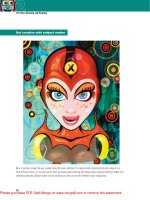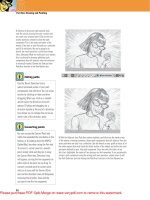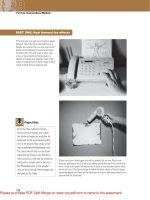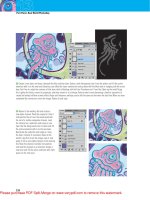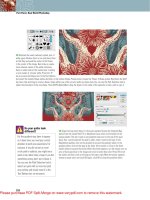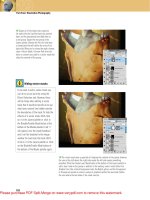Photoshop CS4 Studio Techniques- P15 pot
Bạn đang xem bản rút gọn của tài liệu. Xem và tải ngay bản đầy đủ của tài liệu tại đây (2.3 MB, 30 trang )
406
Chapter 11 Retouching Techniques
Figure 11.44 Original image with dust
and scratches all over. (©2008 Dan
Ablan.)
Figure 11.45 Light-colored scratches
at the cement base of the lion statue
are retouched by using the Clone
Stamp set to Darken.
Automatic Sharpening
The automatic sharpening function in some scanners
makes retouching more diffi cult (Figures 11.46 and 11.47).
If possible, turn off any sharpening settings in your scan-
ning software.
Figure 11.46 Unsharpened image. Figure 11.47 Image sharpened during
a scan.
Cloning Between Documents
With the Clone Stamp, you’re not limited to cloning
from the active document. You can open a second image
and clone from that image as well (Figure 11.48). Make
the second image (the cloning source) active, and then
407
IV: Creative Techniques
Option/Alt-click it. Return to the fi rst image to clone from
the point you clicked in the second image.
Figure 11.48 The photo on the right was judged to be the better choice, but the
girl on the right was missing. With the Clone Stamp, we can clone the girl from
the photo on the left. (©2008 Dan Ablan.)
Clone Source
A handy add-on for the Clone Stamp tool is the Clone
Source panel, which sits in the panel dock (Figure 11.49).
The Clone Source panel offers a number of useful options:
. The fi ve buttons at the top of the panel let you store
as many as fi ve different source points, which makes it
easy to switch from one source point to another during
complex clone operations (such as removing a tree
from in front of a building). This saves you the hassle of
having to reset your clone source point repeatedly.
. Using the Source fi elds, you can adjust any source point
numerically, making it easy to adjust a point that’s off
by just a pixel or two.
. The Rotate fi eld to the immediate right of the Y fi eld
lets you rotate cloned pixels automatically. If you enter
45, for example, the resulting cloned strokes will be
rotated 45 degrees.
When you’re cloning between two
documents, both documents must
use the same color mode (RGB or
CMYK).
Figure 11.49 The Clone Source panel
provides powerful cloning features.
408
Chapter 11 Retouching Techniques
. Above the Rotate fi eld are width (W) and height (H)
fi elds, which let you scale the source while cloning. If
you unlock the lock box between those two fi elds, each
axis will be scaled independently, allowing you to create
a geometric distortion in the result.
. The Show Overlay check box provides a handy visual
reference while cloning. When this box is turned on, a
semi-opaque copy of the source will be superimposed
over the image (how opaque it is depends on the Opac-
ity value), giving you a preview of what your strokes will
look like given the current offset (Figure 11.50). If you
don’t like the results, adjust the offset until the overlay
shows the cloned results in the desired position.
. The Blending Mode pop-up menu and Invert check
box provide options for improving the visibility of the
overlaid source image.
. The Auto Hide option causes the overlay to disap-
pear automatically when you start painting. When you
release the mouse button, the overlay reappears.
Vanishing Point
All the retouching tools we’ve talked about until now have
had one major shortcoming—they treat the world as fl at!
But many images contain objects that appear to change
proportion as they recede from the camera. The solution is
to use Photoshop’s Vanishing Point fi lter (Filter > Vanish-
ing Point), which creates different perspective planes in
an image, thus allowing you to paint, retouch, scale, and
distort in perspective.
The street in Figure 11.51 has a consistent width but looks
smaller in the distance due to the effects of perspective. If
you were to use a standard paintbrush tool in Photoshop
and paint an outline of the street, you’d end up with the
shape shown in Figure 11.52. But with the Vanishing Point
fi lter, you can establish the street’s perspective and then
paint on the image, getting quite a different result (Figure
11.53). Selections made in Vanishing Point will also con-
form to the perspective planes that make up the image
(Figures 11.54 and 11.55).
The Opacity field controls the opac-
ity of the overlaid image—not the
opacity of your cloned strokes.
Figure 11.50 With Show Overlay
turned on in the Clone Source panel,
you can see exactly where the cloned
image will appear. (©2008 Dan Ablan.)
While using Vanishing Point, you
can press the X key at any time to
zoom in on the image temporarily,
which can help you to be more
precise when defining a perspective
plane or performing retouching.
409
IV: Creative Techniques
Figure 11.51 Original image. (©2008
Dan Ablan.)
Figure 11.54 Standard Photoshop
selection. (©2008 Dan Ablan.)
Figure 11.55 Selection made with the
Vanishing Point filter.
Figure 11.52 Standard perspective. Figure 11.53 Vanishing Point
perspective.
Defining Planes
Before you can get all this magic to work properly, you have
to educate Vanishing Point about the image by defi ning
perspective planes. When you fi rst open the fi lter (Filter
> Vanishing Point), you’ll be presented with a large dia-
log and a small tool panel. Choose the Create Plane tool
(which looks like a tiny grid) and click the four corners of a
410
Chapter 11 Retouching Techniques
fl at surface in the image so Vanishing Point is aware of how
the perspective affects that surface. If Vanishing Point is
having trouble with the plane you’re attempting to defi ne,
the lines will change color. If the grid turns red, Vanishing
Point can’t fi gure out how that shape could possibly be a
fl at surface as it relates to the perspective you’re defi ning
(Figure 11.56). If it turns yellow (Figure 11.57), you have
a grid that could be used, but the results will be less than
ideal. When the grid becomes blue (Figure 11.58), Vanish-
ing Point is saying “all systems go,” and you’re ready to start
painting or retouching the image. If you defi ne a plane by
clicking the four corners of a small object, you may need
to extend the side handles so the grid covers the entire sur-
face (or at least the area you plan to modify). If you plan to
work with more than one surface in the image, you’ll have
to defi ne each plane so Vanishing Point knows how those
surfaces relate to each other (Figure 11.59).
Figure 11.56 A red outline is a sign of problems.
Figure 11.58 A blue grid indicates that everything is okay.
Figure 11.57 A yellow grid is usable, but not ideal.
Figure 11.59 Define planes for each surface you intend to
modify. (©2008 Dan Ablan.)
411
IV: Creative Techniques
Duplicating Areas
Once the planes are defi ned, you can use the other tools
from Vanishing Point’s tool panel. If you use the Marquee
tool to make selections, you can hold down Option/Alt
and drag within the selected area to move a duplicate of
the selected area. As you move the selected area, Vanishing
Point scales the image based on the perspective plane on
which you drag (Figures 11.60 and 11.61). But since this
chapter is all about retouching, let’s check out what can be
done with the main retouching tool in Vanishing Point—
the Clone Stamp tool.
Figure 11.60 Sometimes moving
areas produces unrealistic results.
Figure 11.61 Moving areas with the
Vanishing Point filter looks more
realistic.
Cloning in Perspective
Before Vanishing Point came along, Photoshop’s Clone
Stamp tool couldn’t recognize distortions caused by
perspective. Consequently, it created unacceptable results
when used on an image that contained noticeable perspec-
tive distortions. The main problem is that the Clone Stamp
tool is not capable of scaling the cloned area to make it
match the perspective of the surface you’re attempting to
retouch.
412
Chapter 11 Retouching Techniques
In Figure 11.62, the area being covered by the sign is
primarily a row of larger bricks. In Figure 11.63, the row
of large bricks ends up being patched with bricks that are
much too small to look appropriate. The Clone Stamp tool
in Vanishing Point can do a much better job. To start, use
the Create Plane tool to click the two corners that make
up the left edge of a brick; then click the two corners
that make up the right edge of another brick in the same
row, so Photoshop learns how the bricks are distorted by
perspective (Figure 11.64). Then drag the size handles of
the resulting grid to defi ne the overall area that needs to
be retouched (Figure 11.65). Once the plane has been
defi ned, you can use the Clone Stamp tool to retouch
areas, and its results will be scaled to conform to the per-
spective of the image (Figure 11.66).
Figure 11.63 Cloned areas are not scaled to the proper size
and therefore don’t match the surrounding image.
Figure 11.64 The initial plane lines up with a row of bricks.
Figure 11.65 Expanding the plane to cover the area that
needs to be edited.
Figure 11.66 The results are scaled to be the appropriate
size.
Figure 11.62 This wall is distorted
due to perspective. (©2007
iStockphoto.com/belterz.)
413
IV: Creative Techniques
Figure 11.67 The Vanishing Point dialog with the Clone Stamp options visible.
(©2007 iStockphoto.com/urbancow.)
The Vanishing Point Clone Stamp tool incorporates many
of the options that are available in Photoshop’s Healing
Brush, along with a few that are unique to Vanishing Point
(Figure 11.67). For retouching, the settings on the Heal
pop-up menu have particular importance:
. Off. The Hardness setting of the brush is the only thing
that causes retouching to blend into the surrounding
image (Figure 11.68). Use this setting when the area
being retouched is not similar to its surroundings.
. Luminance. Causes the Clone Stamp to copy both color
and texture from the area that’s being cloned; the
brightness of the retouched area is based on the sur-
rounding image (Figure 11.69). Use this setting when
the surface being retouched is unevenly lit, since the
Clone Stamp will match the brightness of the surround-
ing area.
. On. Causes the Clone Stamp to work like the Healing
Brush, copying only texture from the cloned area and
picking up the brightness and color from the area that
surrounds the retouching (Figure 11.70). Use this set-
ting when you want the area being retouched to have
the same texture and color as the surrounding image.
Figure 11.68 Heal set to Off.
Figure 11.69 Heal set to Luminance.
Figure 11.70 Heal set to On.
414
Chapter 11 Retouching Techniques
Dodge and Burn Tools
The words dodge and burn are taken from a traditional pho-
tographic darkroom. In a darkroom, an enlarger projects
an image onto a sheet of photographic paper. While the
image is being projected, you could put something in the
way of the light source, which would obstruct the light in
such a way that it would hit certain areas less than others—
a technique known as dodging. Or you could add light by
cupping your hands together, creating just a small hole
between them, and allowing the light to concentrate on
a certain area more than others—a technique known as
burning. Using a combination of these two methods, you
can brighten or darken an image. Photoshop reproduces
these techniques with two tools: Dodge (its icon looks like
a lollipop, for dodging the light) and Burn (its icon looks
like a hand with fi ngers cupped, for burning).
Dodge Tool
Because it can lighten the image, the Dodge tool is handy
when working on photos of people with dark shadows
under their eyes. An important setting for the Dodge tool
is the Range menu in the options bar (Figure 11.71). The
pop-up menu has three choices: Shadows, Midtones, and
Highlights. This menu tells Photoshop which shades of
gray to concentrate on when you paint across the image:
. Shadows. Changes the dark parts of the image. As you
paint across the image, the brush brightens the areas
it touches. As you get into the midtones, it applies less
paint, and it doesn’t change the light parts of the image
much (if at all).
. Midtones. Affects the middle shades of gray—areas that
are about 25% to 75% gray. It shouldn’t change the
shadows or highlights very much. They may change a
little, but only so they can blend into the midtones.
. Highlights. Affects the lightest parts of the image, slowly
blending into the midtones.
Figure 11.71 Dodge tool options bar.
The Spacing setting of your brush
affects how much the image is
changed when using the Dodge
and Burn tools. Higher Spacing
settings affect the image less.
415
IV: Creative Techniques
With the wrong Range setting for the Dodge tool, you
might cause yourself some grief. Let’s say you’re trying to
fi x dark areas around the model’s eyes in Figure 11.72, but
the Dodge tool doesn’t seem to be doing the job. After
dozens of tries, you fi nally realize that the Range pop-up
menu is set to Highlights instead of Midtones (look at the
eyes in Figures 11.73 and 11.74).
The Exposure setting on the options bar controls how
much brighter the image will become. You can use the
number keys on your keyboard to change this setting.
Color Images
The Dodge tool works exceptionally well on grayscale
images. All you have to do is choose the Range—Shadows,
Midtones, or Highlights—and paint across an area. Unfor-
tunately, the Dodge tool isn’t as slick with color images. It
tends to wash out some of the colors, and in some cases
even change them (Figures 11.75 and 11.76).
One good solution is to duplicate the layer you’re working
on and set the blending mode of the duplicate to Lumi-
nosity before using the Dodge tool. That approach should
maintain the original colors and limit your changes to the
brightness of the image.
Figure 11.75 Original image. (©2008
Dan Ablan.)
Figure 11.76 Area lightened by using
the Dodge tool.
Figure 11.72 Original image. (©2008
Dan Ablan.)
Figure 11.73 Dodge tool set to
Highlights is not working around the
eye area.
Figure 11.74 Dodge tool set to
Midtones.
416
Chapter 11 Retouching Techniques
Figure 11.77 Painting with a light
shade of gray by using the Color
Dodge mode.
Figure 11.78 Area lightened by paint-
ing with a medium shade of gray, using
the Color Dodge blending mode.
Another option is to forgo the Dodge tool and just use
the Paintbrush tool. You can set the Paintbrush tool’s
blending mode to Color Dodge and paint with a bright
shade of gray. But just painting across an image is rather
ridiculous, because all you’re doing is blowing out the
detail (Figure 11.77). To get the Color Dodge technique
to work correctly, paint with a medium to light shade of
gray (Figure 11.78), which allows you to create highlights
or to brighten areas. Sometimes this technique works a
little better than using the Dodge tool.
Burn Tool
The Burn tool is designed for darkening areas of an image.
Like the Dodge tool, it has Range and Exposure options,
and works great with grayscale images. If you’re dealing
with a shiny spot on someone’s forehead or nose that
refl ects the light, you can try to fi x the problem with the
Burn tool (compare Figures 11.79 and 11.80).
Figure 11.79 The original image.
(©2008 Dan Ablan.)
Figure 11.80 The model’s cheeks,
chin, and forehead are darkened with
the Burn tool.
417
IV: Creative Techniques
Color Fixes
Like the Dodge tool, the Burn tool has trouble with color
images (Figures 11.81 and 11.82). Try painting with a
shade of gray (using the Paintbrush tool) and setting the
blending mode to Color Burn, which darkens the image,
making the colors more vivid while leaving the highlights
largely untouched (Figure 11.83).
Figure 11.81 Original image. (©2008
Dan Ablan.)
Figure 11.82 Image darkened using
the Burn tool.
Figure 11.83 Image darkened by
painting with a shade of gray in Color
Burn mode.
Another technique: Option/Alt-click the New Layer icon
at the bottom of the Layers panel. In the New Layer dialog,
change the Mode setting from Normal to Overlay, turn on
the Fill with Overlay-Neutral Color check box, and then
click OK (Figure 11.84). With the new layer active, use
the Dodge and Burn tools with the Range setting in the
options bar set to Midtones (Figures 11.85 and 11.86).
This technique allows you to dodge and burn on a separate
layer, with fewer color problems.
Figure 11.85 Original image. (©2008
Dan Ablan.)
Figure 11.86 Dodge and Burn used
on a layer set to Overlay mode.
Figure 11.84 Creating a new layer in
Overlay mode.
As you dodge and burn, especially
when working on skin tones,
turning on the Protect Tones check
box in the options bar (new in
Photoshop CS4) can help prevent
haloing and washed-out colors.
Hold down Option/Alt to switch
temporarily between the Dodge
and Burn tools, so you don’t have to
go back to the Tools panel each time
you want to switch from brighten-
ing to darkening the photo.
418
Chapter 11 Retouching Techniques
Sponge Tool
Hiding in with the Dodge and Burn tools is the Sponge
tool, which works as if you have a sponge full of bleach,
allowing you to paint across an image and soak up the
color. Or you can do the opposite and intensify the
colors—it’s all determined by the Mode menu setting in
the options bar.
If you choose Desaturate, the Sponge tool tones down the
colors in the area you’re painting. The more you paint
across an area, the closer it becomes to being grayscale.
This technique can be useful when you’d like to make
a product stand out from an otherwise distracting back-
ground (Figure 11.87). With a very low Strength setting, it
brightens yellowing teeth.
The Saturate setting intensifi es colors as you paint over
them, which is great for giving people rosy cheeks, mak-
ing them stand out from a background (Figure 11.88), or
adding a bit more color to their lips. The Sponge tool is a
subtle, yet very effective tool that often is overlooked, but is
exceedingly powerful for photo touchup work.
Figure 11.88 The photographer was enhanced using the Sponge tool set
to Saturate, and the area on the left was retouched with the Sponge tool
set to Desaturate. (©2008 Dan Ablan.)
Figure 11.87 Background and fore-
ground have been desaturated using
the Sponge tool. (©2008 Dan Ablan.)
In Photoshop CS4, the Sponge tool’s
options bar includes a Vibrance
check box that you can use to
prevent oversaturation of colors
that are already saturated, while
boosting less-saturated colors.
419
IV: Creative Techniques
Blurring and Sharpening
When you need to blur or sharpen an area, you have two
choices: Select an area and apply a fi lter, or use the Blur
and Sharpen tools. Using fi lters to blur and sharpen offers
a few advantages over using the tools, including getting a
preview of the image before you commit to the settings,
and having the ability to apply the fi lter effect evenly to
the area you’re changing. But occasionally the Blur and
Sharpen tools can really help when working on small areas,
so let’s take a look at how they work and when to use them.
Blur Tool
The Blur tool is pretty straightforward, blurring everything
that the cursor passes over as you paint across the image. In
the options bar, the Strength setting determines how much
the Blur tool blurs the image; higher settings blur the image
more. This option can be useful if itty-bitty areas of detail
obstruct the image. You might prefer to use the Gaussian
Blur fi lter instead of the Blur tool, however, because Gauss-
ian Blur does a better job of blurring an area evenly.
The Blur tool is good for reducing—not removing—
wrinkles. If you turn the Strength setting way up and paint
across a wrinkle a few times, it begins to disappear, but the
result may not look very realistic (Figures 11.89 and 11.90).
It might look as if you had smeared some Vaseline on the
face. To really do a wrinkle justice, you have to take a closer
look. Wrinkles are made out of two parts: a highlight and a
shadow (light part and dark part). If you paint across that
with the Blur tool, the darker part of the wrinkle will be
lightened and the lightest part will be darkened, so that
they become more similar in shade.
To reduce the impact of a wrinkle without completely get-
ting rid of it (if you wanted to get rid of it, you could use
the Healing Brush tool), turn the Strength setting all the
way up and change the blending mode to either Darken or
Lighten. If the dark area makes the wrinkle most promi-
nent, set the blending mode to Lighten; you might also
need to lower the Strength setting of the Blur tool. Then,
when you paint across the area, the Blur tool will lighten
Figure 11.89 Original image. (©2008
Dan Ablan.)
Figure 11.90 Wrinkles in the forehead
have been blurred using the Blur tool.
Don’t go over the image with the
Blur tool set to Lighten and then
switch over to Darken and go over
it again. That would be the same
as leaving it set to Normal, and you
would be back to Vaseline face.
So use it just once, set to either
Lighten or Darken. Think about
what’s most prominent in the
wrinkle—the light area, or the
dark area? That will indicate which
setting you should use.
420
Chapter 11 Retouching Techniques
that wrinkle. Remember that the Blur tool won’t make the
wrinkle disappear—just reduce its impact.
Consider creating a brand-new, empty layer and sampling
layers with the Blur tool. With this technique, Photoshop
can copy the information from the underlying layers, blur
it, and then paste it onto the layer you just created, leav-
ing the underlying layers untouched. You can easily delete
areas or redo them without having to worry about perma-
nently changing the original image.
Lens Blur Filter
To make a large area of an image blurry, try the Lens Blur
fi lter. Unlike the standard blur fi lters (Blur, Blur More,
and Gaussian Blur), which blur the entire image the same
amount, the Lens Blur fi lter varies the amount of blurring,
based on the contents of a grayscale image (Figures 11.91
to 11.93), which you can create by using the Paintbrush
tool. You can specify which shade of gray represents an
area that you want to keep in focus. Photoshop then makes
all the other areas of the image progressively out of focus,
based on how different the surrounding shades of gray are
compared to the one you specifi ed as the in-focus shade.
Figure 11.91 Original image. (©2008
Dan Ablan.)
Figure 11.92 Grayscale image used
for blurring.
Figure 11.93 Result of applying the
Lens Blur filter using the grayscale
image shown in Figure 11.92.
421
IV: Creative Techniques
The concept is easier to understand when you see this fi lter
in action. Create a new empty layer on top of the image
you want to blur. Press D to reset the foreground color to
black, and then use the Paintbrush tool to paint across the
areas you want to keep in focus (Figure 11.94). The soft-
ness of the brush determines how quickly the focus falls
off, so use a really soft-edged brush if you want a smooth
transition from the in-focus areas to the ones that should
be blurred. To create a much softer edge, choose Filter >
Blur > Gaussian Blur after you paint (Figure 11.95). When
you’re done painting, choose Edit > Fill, set the Use pop-
up menu to White, set the Mode pop-up menu to Behind,
and click OK (Figure 11.96). Photoshop fi lls the empty
areas of the active layer with white.
Figure 11.95 The Gaussian Blur filter Figure 11.96 Use the Fill dialog to fill
the empty parts of the layer with white.
Now we need to get the contents of the active layer to
show up in an alpha channel. Open the Channels panel
(Window > Channels), Command/Ctrl-click the top chan-
nel (it will be called Gray, RGB, or CMYK, depending on
which mode the image uses) to get a selection, and then
click the second icon from the left at the bottom of the
Channels panel to generate the alpha. If necessary, click
the eyeball icon to make this layer visible. To get back
to working on the original image, click back to the Lay-
ers panel or choose Window > Layers, drag the layer you
painted onto the trash icon, choose Select > Deselect, click
the layer you want to blur, and then choose Filter > Blur >
Lens Blur.
Figure 11.94 Paint with black on a
new layer to define the areas that
should remain in focus. (©2008
Dan Ablan.)
422
Chapter 11 Retouching Techniques
When the Lens Blur dialog appears (Figure 11.97), turn on
the Preview check box and choose Faster for the Preview
method. (The More Accurate setting is just too darn slow.)
In the Source pop-up menu, choose the name of the alpha
channel you created (Alpha 1, unless you renamed it).
Move your mouse over the preview image and click the
area you wanted to keep in focus. Clicking the image sets
the Blur Focal Distance setting, specifying which shade of
gray in the alpha channel will be used to represent an area
that should be in focus (0 = black). If you’d rather have
that area become blurry, turn on the Invert check box. To
compare the blurred version of the image to the original,
toggle the Preview check box off and on.
Now that you have the fi lter set up, it’s time to fi gure out
how you want the blurry areas of the image to look. The
Radius slider determines just how blurry areas should
become. When you purposefully throw an area out of focus
using a camera (by using a low-aperture setting), you’ll
often see the shape of the aperture in the highlights of the
image (Figure 11.98). The Shape, Blade Curvature, and
Rotation settings attempt to simulate the shape of an aper-
ture in the brightest areas of the image.
Figure 11.97 The Lens Blur dialog. (©2008 Dan Ablan.) Figure 11.98 The shape of the camera aperture often
shows up in the brightest areas of the image.
When you blur an image, the brightest areas of the image
often start to look a bit dull (Figures 11.99 and 11.100).
That happens because blurring blends those bright areas
into their surroundings, which makes them become
darker. To compensate, increase the Brightness setting
until the highlights in the image become bright again
423
IV: Creative Techniques
(Figure 11.101). The Threshold setting determines which
shades will be brightened. Moving the slider left causes
Photoshop to brighten more shades, whereas moving it
right brightens only the brightest shades in the image.
Figure 11.99 Original image.
Figure 11.101 Adjusting the
Brightness setting brings back
the brightness in the highlights.
Figure 11.100 The highlights look dull after blurring
the image.
Blurring an image usually removes any grain or noise that
was in the image (Figure 11.102). Because the Lens Blur fi l-
ter doesn’t blur the entire image, you might end up with a
lot of grain in the in-focus areas of the image and no grain
in the blurred areas. That will make the image look very
unnatural, because the original image contained consistent
grain across the entire image. To add grain into the blurred
areas, experiment with the Noise setting at the bottom of
the Lens Blur dialog. Move the Amount slider right until
the blurry areas have as much grain as the in-focus areas
(Figure 11.103); then switch between the Uniform and
Gaussian options until you determine which one delivers
the best match to the grain of the original photo. Turn on
the Monochromatic check box if the blurred areas look too
colorful when compared to areas that haven’t been blurred.
Figure 11.102 All the grain was
removed when the left side of this
image was blurred.
Figure 11.103 Adjusting the Noise
settings added grain back into the
blurred area.
424
Chapter 11 Retouching Techniques
Sharpen Tool
The Sharpen tool works in a fashion similar to that of its
relative, the Sharpen fi lter. But with this tool you have to
adjust the Strength setting in the options bar to determine
how much to sharpen the image. Be careful, though; if
you turn the Strength setting up too high or paint across
an area too many times, you’ll get some really weird effects
(Figures 11.104 to 11.106).
Figure 11.104 Original image. (©2008
Dan Ablan.)
Figure 11.105 Sharpened using the
Sharpen tool with a medium Strength
setting.
Figure 11.106 Sharpened using the
Sharpen tool with a high Strength
setting.
Sharpening Reflections
When an image contains glass, metal, or other shiny
objects, it usually contains extremely bright highlights
(known as specular highlights). This usually happens when
light refl ects directly off one of those very shiny areas,
such as the edge of a drinking glass. These extra-bright
highlights often look rather fl at and lifeless after being
adjusted (Figure 11.107). This happens because when-
ever we adjust an image to perform color correction, or
prepare it for printing or multimedia, the brightest areas
of the image usually become 3% or 4% gray (instead of
white). But if you sharpen those areas, you’re going to
brighten them and make them pure white. This will make
them stand out and look more realistic. So any time you
have something shiny, such as buildings, jewelry, glass-
ware, or refl ected light in people’s eyes, use the Sharpen
tool, bring down the Strength to about 30%, and go over
those areas. That will make them almost pure white; when
you print them, they’ll almost jump off the page (Figures
11.108 and 11.109).
425
IV: Creative Techniques
Figure 11.107 Metallic highlights
often look a bit dull after performing
color correction. (©2008 Dan Ablan.)
Figure 11.108 The areas covered in red
were sharpened to make them pop.
Figure 11.109 Metallic highlights
sharpened.
The Blur and Sharpen tools make subtle changes. When
you want a bit more radical change, try using the Blur and
Sharpen fi lters instead. The Lens Blur fi lter gives you the
most control over blurring an image, but at the same time
it’s usually the slowest method for blurring.
Now let’s get away from traditional retouching techniques
and see how we can correct distorted images.
Lens Correction Filter
The Lens Correction fi lter (Filter > Distort) is designed to
correct for distortion that’s caused by the camera lens itself,
or by the angle of the lens relative to the subject of the
photo. Let’s start off with a quick tour and then get busy fi x-
ing some images. Since this fi lter is often used on subjects
that contain a lot of vertical and horizontal lines (such as
buildings), a grid is provided to help you see when you’ve
removed all the distortion from an image (Figure 11.110).
You can toggle the grid on and off with the Show Grid
check box, control the amount of space between grid lines
with the Size setting, and reposition the grid by using the
Move Grid tool (which looks like a hand on top of a grid).
You can zoom in and scroll around
the image by using the Zoom and
Hand tools in the Lens Correction
dialog, but you might prefer to use
the standard keyboard shortcuts of
holding down Command/Ctrl and
pressing the plus or minus keys,
and using the spacebar to access
the Hand tool temporarily.
426
Chapter 11 Retouching Techniques
After you’ve experimented with some of the Lens Correc-
tion sliders, toggle the Preview check box to see what the
image looks like before and after the correction has been
applied. Now that you know your way around the dialog,
let’s see what all those sliders can accomplish.
Remove Distortion
The Remove Distortion slider is designed to correct for
barrel or pincushion distortion. That’s when the image
ends up bent out away from the center or bent in toward
the center. You’ll see this effect sometimes with very wide
angle lenses and subjects shot close up, which causes verti-
cal lines to become curved. Move the Remove Distortion
slider, or drag on the image with the Remove Distortion
tool (at upper left in the dialog). The grid is quite useful
when adjusting this slider, since it’s often hard to tell if
something is perfectly straight.
Chromatic Aberration
The Chromatic Aberration sliders are designed to get rid
of color fringing that often appears on the edge of high-
contrast objects (Figures 11.111 and 11.112). This fring-
ing is caused by light being bent as it passes through the
elements that make up a camera lens, which causes the
light to bend and separate much like white light turns into
a rainbow of color when sent through a prism. You won’t
see this fringing on every image, and you’ll only be able to
notice it when you zoom in to 100% view.
Figure 11.110 The Lens Correction
dialog. (©2008 Dan Ablan.)
427
IV: Creative Techniques
Figure 11.111 Original image. (©2008 Dan Ablan.) Figure 11.112 Result of correcting for chromatic aberration.
Vignette
Moving the Vignette Amount slider toward the right
causes the corners of the image to become brighter,
whereas moving it left darkens the corners. The Midpoint
slider determines how far this brightness change intrudes
toward the middle of the document. Darkened corners
visually direct the viewer’s attention toward the middle of
the image (Figures 11.113 and 11.114).
Figure 11.113 Original image. (©2008
Dan Ablan.)
Figure 11.114 Darkening the corners
with vignetting.
You might see vignetting when
shooting a Nikon digital system
with lenses that are not rated for
the camera at hand, such as an FX
lens on a DX body.
428
Chapter 11 Retouching Techniques
Transform
The Angle setting in the Transform section of the Lens
Correction dialog simply rotates the image, which can be
useful if the horizon line isn’t level. Click the tool and then
drag across an area in the image that should be horizontal
or vertical. Photoshop calculates the proper rotation set-
ting needed to straighten the area.
The Vertical Perspective and Horizontal Perspective slid-
ers make converging horizontal or vertical lines parallel
(Figures 11.115 and 11.116). This is useful when you take a
shot of a building by pointing your camera upward toward
the top of the building, which usually causes the top of the
building to appear smaller than the bottom in the result-
ing photograph.
The Edge setting determines what should be placed in
any transparent areas of the image that are caused by the
distortion correction you’ve applied. Leave the setting set
to Transparency if you prefer to work on the transparent
areas yourself.
Now that you have an idea of how to fi x distorted images,
let’s shift gears and start applying creative distortions.
Liquify Filter
The Liquify fi lter allows you to pull and push on an
image as if it were printed on Silly Putty. The results you
get out of this fi lter will either be obvious (looking like a
refl ection in a funhouse mirror) or not noticeable to the
untrained eye. It all depends on your intentions. When
you choose Filter > Liquify, you’ll see a dialog that domi-
nates your screen (Figure 11.117). Later you can play
with the more extreme uses of the Liquify tools and con-
jure up special effects to your heart’s content, but for now
let’s use a more real-world approach. The incremental
changes will be subtle, so pay close attention to the cap-
tions for each fi gure.
Figure 11.115 Original image. (©2008
Dan Ablan.)
Figure 11.116 Result of adjusting
vertical perspective.
429
IV: Creative Techniques
First let’s consider the tools in the Liquify dialog’s toolbar
at upper left. The fi rst tool is called Forward Warp. Click
Forward Warp and paint on the image to push it in the
direction you’re dragging (Figure 11.118). If the results
go a little too far, grab the Reconstruct tool (the next tool
down) and paint across the area that you want to take back
to normal (Figure 11.119). The more you paint across
an area, the closer it becomes to the original (before you
applied the Liquify command).
Figure 11.119 Reconstruct decreases
the Spock effect.
Figure 11.118 Forward Warp gives
this child some cool ears. (©2008
Dan Ablan.)
The Twirl Clockwise tool slowly rotates the area inside
the cursor clockwise; hold down Option/Alt to rotate
counterclockwise (Figure 11.120). The Pucker tool
allows you to pull the image in toward the center of your
Figure 11.117 The Liquify dialog.
(©2008 Dan Ablan.)
The Liquify settings vary based
on the image you’re using and
the amount of precision required
to complete each task. The set-
tings suggested here are a good
starting point.
430
Chapter 11 Retouching Techniques
brush (Figure 11.121), and the Bloat tool does the oppo-
site (Figure 11.122).
The Push Left tool acts as though the line you draw is a
bulldozer, and pushes the image away from it on the left
side (Figure 11.123). Press Option/Alt to move the image
on the right side instead. The Mirror tool fl ips a portion
of the image horizontally or vertically, depending on the
direction you drag. If you drag downward, you’ll refl ect the
area to the left of the cursor. Drag up to refl ect the area
to the right (Figure 11.124). Drag right to refl ect the area
below the cursor, and drag left to refl ect the area above.
The Turbulence tool allows you to push and pull on the
image, much like the Warp tool, but adds more of a wavy
look, which can be useful when you’re attempting to create
water ripples and smoke (Figure 11.125).
Figure 11.121 Pucker tool purses the
boy’s mouth.
Figure 11.124 Mirror tool used on his
mouth.
Figure 11.122 Bloat tool at work on
the eyes.
Figure 11.125 Turbulence tool used
on his hair.
Figure 11.120 Twirl tool used on the
boy’s hair.
Figure 11.123 Push Left tool used on
the child’s mouth.
Hold down Option/Alt to switch
temporarily between the Pucker
and Bloat tools.
